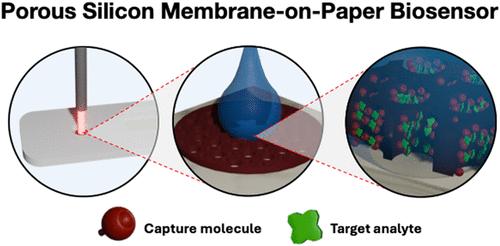纸上多孔硅:定量快速诊断测试的平台
IF 8.2
2区 材料科学
Q1 MATERIALS SCIENCE, MULTIDISCIPLINARY
引用次数: 0
摘要
硅衬底上的多孔硅(PSi)薄膜在生物传感应用中得到了广泛的研究,特别是在实现各种分析物的无标签光学检测方面。然而,大规模运输的挑战使得这些生物传感器难以实现快速响应时间和低检测限。在这项工作中,我们介绍了一种通过在流过传感器方案中使用纸基板上的开放式PSi膜来提高PSi分子运输效率的方法。纸基板提供结构支持,以及从PSi膜排水溶液的有效手段,而无需使用外部泵和微流体通道。当分子在膜中被捕获时,测量了PSi膜的反射特性的明显变化。一个浓度依赖的响应传感器的蛋白质检测被证明。讨论了影响PSi膜中分子相互作用时间和膜干燥时间的因素,这些因素直接影响检测灵敏度和整体测试时间。所演示的纸上硅传感器的性能建立了一个具有高灵敏度、定量读数的低成本快速诊断测试平台的可行性。本文章由计算机程序翻译,如有差异,请以英文原文为准。

Porous Silicon on Paper: A Platform for Quantitative Rapid Diagnostic Tests
Porous silicon (PSi) thin films on silicon substrates have been extensively investigated in the context of biosensing applications, particularly for achieving label-free optical detection of a wide range of analytes. However, mass transport challenges have made it difficult for these biosensors to achieve rapid response times and low detection limits. In this work, we introduce an approach for improving the efficiency of molecule transport in PSi by using open-ended PSi membranes atop paper substrates in a flow-through sensor scheme. The paper substrate provides structural support as well as an efficient means of draining solutions from the PSi membrane without the use of an external pump and microfluidic channels. Distinct changes in the reflectance properties of the PSi membrane are measured when molecules are captured in the membrane. A concentration-dependent response of the sensor for protein detection is demonstrated. Factors influencing the interaction time of molecules in the PSi membrane and the drying time of the membrane, which directly affect the detection sensitivity and overall testing time, are discussed. The demonstrated performance of the PSi-on-paper sensor establishes the feasibility of a platform for low-cost rapid diagnostic tests with a highly sensitive, quantitative readout.
求助全文
通过发布文献求助,成功后即可免费获取论文全文。
去求助
来源期刊

ACS Applied Materials & Interfaces
工程技术-材料科学:综合
CiteScore
16.00
自引率
6.30%
发文量
4978
审稿时长
1.8 months
期刊介绍:
ACS Applied Materials & Interfaces is a leading interdisciplinary journal that brings together chemists, engineers, physicists, and biologists to explore the development and utilization of newly-discovered materials and interfacial processes for specific applications. Our journal has experienced remarkable growth since its establishment in 2009, both in terms of the number of articles published and the impact of the research showcased. We are proud to foster a truly global community, with the majority of published articles originating from outside the United States, reflecting the rapid growth of applied research worldwide.
 求助内容:
求助内容: 应助结果提醒方式:
应助结果提醒方式:


